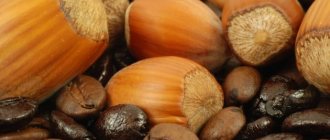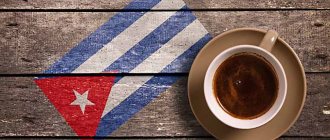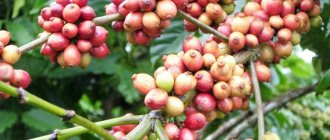Cuba is famous not only for rum and cigars, but also for delicious coffee. Cuban coffee is produced much less than Colombian and Brazilian coffee. The drink is popular due to its taste. True coffee lovers prefer it. It is distinguished by its strong strength and rich aroma, invigorates and energizes. Therefore, Cuban coffee is valued all over the world.
How the drink came about
Coffee beans were first imported from Haiti in the eighteenth century. At that time, serious tree care was organized and strict control over product output was carried out. Thanks to the creation of ideal conditions and a warm, humid climate, the bushes began to produce a large harvest of grains.
Over time, the volume of coffee plantations grew and in the nineteenth century, Cuba occupied a leading position in the export of this product. The Cuban drink has a pronounced rich taste, slight sourness, and contains chocolate and tobacco notes.
Features of coffee production in Cuba
Historically, coffee plantations were concentrated in the eastern regions - in Guantanamo and Baraxo, in the foothills of the Sierra Maestra. Gradually, plantings spread to the west and center of the island. Today, among the main production sites:
- Sierra de Trinidad;
- Sierra del Rosario;
- border of Jagüey Grande and Quivicana (near Havana).
Over the past 60 years, the area of plantations has decreased by 6 times. However, there has been some recovery since 1996.
Since 2003, organic plantations have appeared where no chemical fertilizers are used. Certified products are exclusively exported to European countries, and since 2011 – to Japan.
Cuban coffee Cubita (Cubita)
Today, Cuba supplies the coffee market with dozens of varieties of Arabica beans. The drink is called Qubita, which has many different varieties. The best are considered:
Altura
Popular not only among local residents, but also outside the country. Cubans value it for its high caffeine content and rich aroma. The finished drink is quite thick and has some bitterness and astringency in its taste.
Maragogyp
One of the best Cuban varieties. Refers to high quality drinks. Brewed coffee has a strong aroma and thick consistency. The invigorating drink has a burning aftertaste, which adds originality to it.
Guantanamo
The famous Arabica variety grows in the Sierra Maestro mountain region in the city of Guantanamera. Similar varieties are Granma and Holguin, which are named after the places where they are grown. These varieties lack sourness. The prepared coffee has the aroma of tobacco and has a burning tart taste. Cubans value these varieties for their strong strength, which is expressed in the drink, which is achieved due to the high caffeine content.
Features of different varieties
- Turquino Montanes. A blend of different types of Arabica. It has a bright and tart taste. The aroma contains notes of citrus and dark chocolate. If you savor the drink, the presence of chili pepper, cocoa beans and tobacco is felt in the aftertaste.
- "Altura". Consists of 100% Arabica. Taste - chocolate-tobacco - rich. There is a slight sourness. The aftertaste contains hints of tropical fruits.
- Caracolillo. Blend of 100% Arabica. The grains were grown and harvested in the mountain plantations of the Sierra del Rosario. They are shaped like small shells. The taste is perfectly balanced between bitterness and sourness. There is a rich chocolate shade and a soft aroma.
- Serrano Selecto. The same applies to Arabica blends. In addition to notes of chocolate, there is a creamy tint in the taste. The aroma is multifaceted and reveals itself gradually. These beans are suitable for those who want to taste real Cuban coffee.
- Guantanamera. Named after a famous Cuban song. It tells about a man who loved a girl, but she left him. The coffee has a delicate taste. There are fruity and floral notes, but the sourness is almost not noticeable.
- Arriero Puro. A blend of different Arabica varieties. It has a rich sweet aroma. There are some notes of chocolate, flowers and fruit on the palate. This makes it especially tender.
Cuban coffee is suitable for different preparation methods. You can make espresso or latte. There is also a special option: a little cane sugar is mixed with a small amount of coffee and whipped into foam. Then the finished espresso is poured into the cup. This method of preparation makes the drink sweet.
We directly supply Cuban coffee, so you can be sure of its freshness and originality. See the entire range in the catalogue.
How to brew real Cuban coffee
Now you can find many different recipes for making the drink. But, following the basic rules, it should be: very hot, very sweet and strong. Cubans prepare it according to the principle of “more coffee, less water.” The caffeinated Cuban invigorating drink is quite thick. For this recipe, only grains that grow on Cuban plantations are used.
In order to brew real Cuban coffee, you must follow some rules:
- Grains must be ground before cooking;
- The drink will turn out very tasty and aromatic if you brew it in a geyser coffee maker (the beans are prepared under high steam pressure);
- To reveal all the qualities of coffee, it is better to add cane sugar;
- The beans should not be freshly roasted;
- You need to brew the drink with a good positive attitude.
Cuban coffee recipe
If you don’t have a geyser coffee maker, brew the drink in a Turk. You will need the following ingredients:
- Two teaspoons of coffee beans;
- Two hundred milliliters of water.
- A tablespoon of cane sugar;
- Rum to taste.
Grind the grains before starting cooking. Mix coffee and sugar in a pot, pour in water and bring to a boil on the stove. It is better to cook over low heat; when the mixture begins to boil, remove the Turk from the stove. Wait a few minutes for the grains to settle. Now you can add rum as desired or replace it with cognac, which will affect the taste of the coffee. The real drink in Cuba is prepared with rum, served in small cups and drunk very hot.
Just a few quick facts to get you started: coffee from Cuba is an extremely rare species, because it is simply in short supply. This makes it quite expensive, but not as much as one would expect when assessing the scale of production. I believe that, relative to export volumes, the low price of Cuban coffee is due, in part, to the fact that, to put it mildly, not everyone likes it. Cuban Arabica is one of the most non-acidic in the world. This is exactly what many people like. But it also has obvious descriptors of tobacco, smoking and roasted seeds. She's clearly an amateur, but among the amateurs there are real fans.
Cuban coffee is in 99% of cases washed Arabica, growing at an altitude of up to 800 m
The first coffee tree on Liberty Island was grown by José Antonio Gelabert in 1748. But production expanded to some tangible scale only at the end of the 18th century. The impetus came from French colonists fleeing the Haitian revolution. They settled in Cuba and planted the trees they brought with them in the Sierra Maestra region. This is a mountain range in the southeast of the country. The highest point is Turkino Peak with a height of 1974 meters.
Portrait of José Antonio Gelabert from the collection of the Denver Art Museum.
But the plantations are not located so high, not at the top, but at the foot of the mountains. The Sierra Maestra is the main growing region for Cuban coffee; the typical altitude at which trees grow is 400-800 meters. But this is not the only coffee-producing region; nearby, just a little to the east, there is another ridge - Nipe Sagua-Baracoa, and in the center of the island is the Escambray plateau. But even there, plantations are located at approximately the same altitude - 400-800 meters above sea level. Therefore, coffee from Cuba is one of the lowest grown in the world.
The coffee trees themselves have genetic relatives from Puerto Rico and Jamaica and are a subspecies of Arabica typica. Robusta does not seem to be grown at all in Cuba. And Arabica beans are literally a drop in the ocean of global production. In 2022, about 900 tons of coffee were exported from Cuba. For comparison, neighboring Mexico produced about 240,000 tons (you can study the top producers here). Jamaica, yes, supplies about the same amount. But compare the price of coffee from Jamaica and from Cuba.
Coffee trees grow on mountain slopes, in the shade of other, larger plants that protect coffee from heavy rainfall. Harvesting is done manually. There are still no clear roads around the plantations; farmers have to carry the harvest by hand to the fermented dirt roads, along which the grains are sent by mule to the processing station. As far as I know, all stations are owned by the state, represented by the exporting company CubaExport. Government regulation is one of the reasons for the relatively affordable (taking into account export volumes) prices for Cuban coffee. The second reason is that there is no need to use expensive fertilizers, because the soils are rich in microorganisms, which already provide the trees with a good “food base”.
Characteristics of Cuban coffee, how to decipher the name
Let's take the most common name for freshly roasted Cuban coffee from domestic, as well as any foreign, roasters: “Cuba Serrano Lavado.” The first word is clear, country of origin. Let's look, no, not at the second, at the third - “Lavado”.
Due to heavy rains, dry processing is not practiced in Cuba, so all the Cuban coffee I have ever encountered was exclusively washed. I talked about processing methods in a profile article about coffee for a coffee machine.
The type of processing – washed – is precisely encrypted in the name: “Lavado”. By the way, you won’t find this hint anywhere in RuNet. Everyone, even roaster consultants, believes that Lavado is “the name of a variety of Arabica that grows in Cuba.” Since they do not practice any other processing there and all lots are labeled “Lavado,” it is not surprising that this has become synonymous with “coffee from Cuba.” And only the most advanced know that “Lavado” is simply “Washed” in Spanish.
It's time for the second word - "Serrano". We sell store-bought Cuban coffee, which is allegedly produced by . In fact, the company is different, but that’s not the point. The main thing is that this word in any case means only a screen of grains, their size. In another way, you can say “grade” (rating), for Cuban coffee it is tied to size.
- “ Serrano ” is the smallest grain size (but larger grains can also be found, the classification is simply based on the smallest). Corresponds to grain screen “15”, if we draw an analogy with the most understandable Brazilian classification.
- Next comes “ Altura ” - screen from 16.
- “ Turquino ” (remember, the highest point of Cuba?) – 17-18.
- “ Extra Turkino ” is the largest grain size, an analogue of 18+ or AA screen for Kenya.
That is, in Brazil, size is indicated by numbers, in Kenya by letters, and in Cuba by words.
I've never even tried Extra Turkino. From the other three, I personally concluded that the taste in the cup practically does not depend on the size. Although, as usual, the larger the grain, the more expensive it is when exported, and it is considered purer in terms of the final taste. I believe that the final taste, its balance and purity, in the case of Cuban coffee, depend much more on the roasting profile.
It turns out that “Cuba Serrano Lavado” reads like “Washed Arabica from Cuba 15th screen.” Where is the clarification of the region, farm, processing station in the name? Somehow they are not used to this. Either it’s a state monopoly, or a backwardness of approaches, or maybe unification for the sake of economy, but I haven’t seen Cuban coffee in the form of microlots with a specific geographic location. If you have met, please drop a line in the comments.
Description of taste
But even washed processing of grains, which always adds acidity to the final drink, is not able to overcome the terroir: low altitude, island climate, abundance of volcanic ash and minerals in the soil. As a result, the taste of coffee from Cuba has minimal acidity, regardless of the preparation method. The major will always have cocoa, dark chocolate, roasted nuts and tobacco notes. A slight citrus sourness may appear in the background, but extremely rarely.
Of course, roasting greatly affects the taste. And, I repeat, I believe that it is she who sets the differences among all Cuban coffee, and not the original beans, their grade or processing (fortunately, all this is approximately the same). Coffee from Cuba is usually roasted either medium or slightly darker. I have seen experiments with light roasting, but the results were completely controversial. The family tobacco and smoky descriptors remained, but they were mixed with damp wood, raw nuts and the taste of rotten grass. And against the background of this is dim, but caustic ascorbic acid.
Whatever marketers write about “soft, enveloping, creamy caramel taste,” you need to soberly understand: that’s not what Cuban coffee is about.
In any lot and blend at any roast, I clearly felt the characteristic heaviness (sometimes worse than that of Robusta), strength (the lower Arabica grows, the more caffeine it contains, that is, I’m talking about real strength, and not about a euphemism) and the drag of smoldering premium quality pipe tobacco. This is in the best examples. In the worst cases - cheap cigarettes, burnt seeds, coal from the rain-drenched firebrands of yesterday's fire.
You really need to be able to fry Cuba in such a way as to emphasize the existing sweetness - and it does have it: milk chocolate or even Snickers, sweet nuts like macadamia and cashews, cane sugar - and not go into the terminal stage of the coal-tobacco vector. But if you succeed, then in the cup you will find a very dense, syrupy drink at the level of high-quality robusta with a round, velvety body, chocolate-nut liqueur in the taste and an expensive Cuban cigar in the aftertaste.
You can cook Kuba in any way, but it is clear that in the case of dark roasting there is no alternative. But dark Cuba, for the reasons stated above (going into coal), is, in principle, very controversial, I think. Except for dairy drinks. Although Cuba, in principle, goes well with milk, and in medium roast too, dark roast is not needed for this. It is especially popular for Turks and least popular in methods with coarse grinding - French, cup - where you usually get a faceless infusion “with smoke”. Personally, I perceive it only in the form of espresso.
Prices, where to buy Cuban coffee in Moscow, St. Petersburg and the regions
Bravos, -20% using my promo code 101KOFE
- Cuba Serrano Lavado, medium roast ~2301 RUR/kg.
Tasty Coffee, -10% using my promo code 101KOFE
- Cuba Serrano Lavado, SCA 81, light roast ~2009 RUR/kg.
Torrefacto
- Cuba Serrano Lavado, SCA 82.25, dark roast ~2286 RUR/kg.
- Cuba Turkino Lavado, SCA 83.75, medium roast ~2649 RUR/kg.
This article uses photographs by Yanik Flowers, HAI VAN NGUYEN TONG and Milo Miloezger (Unsplash, Pixabay).
Publication date: 12/23/2021.
Your opinion is important to me. Please rate the material: (Total ratings: 5. Average: 4.80 )
Cuban green coffee
The first coffee plantations appeared in Cuba. But now it is almost impossible to purchase due to the introduction of American sanctions. There are several reasons why green coffee is very difficult to find:
- Very small volumes of products. Despite this, local authorities want to resume production processes;
- Due to the imposition of sanctions by America, many countries have lost economic ties with Cuba;
- Only Russia and China are considered the main consumers of Cuban coffee.
Arabica grows in Cuba, and its quality is no worse than that of other world producers. It does not have a strong sourness, like American varieties. Now not everyone can afford to drink a real and high-quality Cuban drink.
History of the drink
The first grains were brought to Cuba back in the 18th century. The mild climate was ideal for growing coffee, and in less than half a century, from 1748 to 1791, plantations spread to cover almost the entire southeast of the island. The focus of production was Cuban Santiago and Guantanamo Bay. Most of the products were exported to Europe and the USA.
The turning point was the Cuban Revolution of 1953-1956. With the coming to power of the Barbados, led by General Castro, all enterprises in the country were nationalized. Many specialists who did not agree with the new regime were forced to leave the young republic. These changes also affected coffee production – its volumes decreased significantly.
In 1962, after the United States imposed an embargo on the import of goods from Cuba, the USSR and the socialist countries became one of the few importers of Cuban coffee. But in 1991, after the collapse of the Soviet Union, the republic lost most of its market.
Production decreased by 5 times. Even after the embargo was lifted in 1996, it was not possible to restore the country’s position in the coffee market. If before 1990 Cuba produced 440 thousand bags of coffee, today this figure barely reaches 130 thousand.
Attention!
Cuba's coffee plantations are included in the UNESCO list of world historical, cultural and natural attractions.
Price
The drink has an affordable price for everyone. A package weighing one kilogram can be bought for one and a half thousand rubles. The price of fresh harvest may be higher.
Fans of this amazing drink will be pleased with its quality. Cuban coffee varieties are considered one of the best. Trying it for the first time, many remain fans for life. Tourists always bring cigars, Cuban rum and, of course, coffee from Cuba. Cuba supplies coffee blends to the world market, so you can try it in its pure form only within the country.
The secret of unusual taste
Cuban varieties are very different from coffee produced in Italy, France and Switzerland from beans grown in Africa and Latin America. To be eligible to be called Qubita, a drink must meet a number of conditions:
- grains are grown only in Cuba;
- Only dark roast is used;
- contains a large amount of caffeine.
Cuban coffee is characterized by increased bitterness, therefore, to evaluate the taste, a little sugar is added to the finished drink to soften it. Characterized by tart and pungent notes.
Attention!
Traditionally, coffee plantations coexist with tobacco plantations. This also greatly affects the taste and aroma. Qubita definitely has smoky cigar notes.
Features of preparing coffee in Cuban style
In Cuba, the coffee drink is usually prepared with rum. The following ingredients are used:
- 15 g ground beans;
- 15 g granulated cane sugar;
- 200 ml water;
- 15 ml rum.
The following actions are performed:
- The coffee beans are ground.
- The resulting coffee powder is poured into a Turk and mixed with granulated sugar.
- Water is poured into the cezve.
- The container is placed on the stove.
- When the liquid begins to boil, the Turk is set aside.
- The drink is infused for a couple of minutes, after which it is poured into a cup.
- Rum is added to the composition.
Cuban coffee has unusual taste characteristics. Therefore, it has earned popularity among coffee lovers. The drink is strong and incredibly aromatic. This result is achieved regardless of which variety is chosen.











